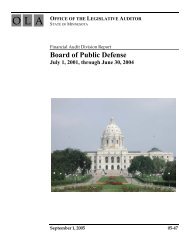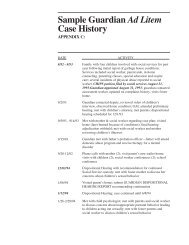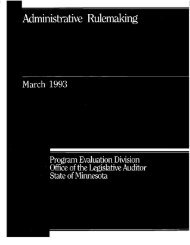Occupational Regulation - Office of the Legislative Auditor
Occupational Regulation - Office of the Legislative Auditor
Occupational Regulation - Office of the Legislative Auditor
You also want an ePaper? Increase the reach of your titles
YUMPU automatically turns print PDFs into web optimized ePapers that Google loves.
22 OCCUPATIONAL REGULATION<br />
The Task Force also made specific recommendations that <strong>the</strong> Legislature repeal<br />
<strong>the</strong> statutory authority <strong>of</strong> some boards and expand o<strong>the</strong>rs. In addition, <strong>the</strong> Task<br />
Force recommended fur<strong>the</strong>r study for certain issues, including: changing <strong>the</strong><br />
regulatory status <strong>of</strong> selected occupations, consolidating smaller boards, and<br />
increasing public membership on regulatory boards. Despite <strong>the</strong> variety <strong>of</strong> Task<br />
Force recommendations none were immediately implemented, and <strong>the</strong>y had<br />
minimal impact on occupational regulation in Minnesota.<br />
Commission on Reform and Efficiency Report<br />
Sixteen years after <strong>the</strong> Department <strong>of</strong> Administration report, <strong>the</strong> Minnesota<br />
Commission on Reform and Efficiency (CORE) issued A Minnesota Model -<br />
Recommendations for Reorganizing <strong>the</strong> Executive Branch in 1993. This<br />
wide-ranging report addressed <strong>the</strong> problems <strong>of</strong> accountability for small agencies.<br />
CORE recommended that boards, commissions, councils, and advisory task forces<br />
should be administered by existing departments ra<strong>the</strong>r than allowed to exist as<br />
fully independent entities. The CORE report saw this as one way <strong>of</strong> consolidating<br />
staffing and support activities and easing procedures for reporting within <strong>the</strong><br />
executive branch.<br />
Subcommittees<br />
<strong>of</strong> <strong>the</strong> House<br />
and Senate<br />
studied<br />
occupational<br />
regulation in<br />
<strong>the</strong> 1990s.<br />
Ano<strong>the</strong>r part <strong>of</strong> <strong>the</strong> report <strong>of</strong>fered two recommendations specifically about<br />
regulatory boards. It suggested that <strong>the</strong> Legislature create a central licensing<br />
agency to perform administrative functions for <strong>the</strong> boards while allowing<br />
licensing boards to remain independent, and it suggested that all pr<strong>of</strong>essional<br />
licensing boards should go through sunset reviews over a four year period starting<br />
in 1994. Nei<strong>the</strong>r <strong>of</strong> <strong>the</strong>se recommendations were implemented.<br />
Interim Subcommittees and Legislation<br />
During <strong>the</strong> 1990s <strong>the</strong> State Legislature convened two interim committees to study<br />
<strong>the</strong> issue <strong>of</strong> occupational regulation. In <strong>the</strong> Fall <strong>of</strong> 1991 an <strong>Occupational</strong><br />
Licensing Subcommittee <strong>of</strong> <strong>the</strong> House Governmental Operations Committee met<br />
to learn about <strong>the</strong> scope <strong>of</strong> occupational regulation and <strong>the</strong> process by which<br />
proposed occupational regulation was evaluated. Throughout <strong>the</strong> Fall, board and<br />
agency staff, pr<strong>of</strong>essional groups, academic researchers, and o<strong>the</strong>rs provided<br />
background information and <strong>of</strong>fered testimony on <strong>the</strong> effectiveness <strong>of</strong> <strong>the</strong> current<br />
system <strong>of</strong> occupations regulated by independent boards and state departments.<br />
With this input, subcommittee members traced <strong>the</strong> history <strong>of</strong> occupational<br />
regulation in Minnesota and discussed inconsistencies in regulatory requirements.<br />
In 1992, following <strong>the</strong> subcommittee hearings, H.F. 2298 was introduced to<br />
establish a legislative commission on occupational regulation. A ten member joint<br />
commission was proposed to review proposals for occupational regulation in light<br />
<strong>of</strong> Chapter 214 and recommend whe<strong>the</strong>r new regulatory programs should be<br />
adopted and which departments should perform <strong>the</strong> regulatory functions. The<br />
commission would also research and analyze trends in occupational regulation<br />
and review regulated occupations to assure that <strong>the</strong>y comply with <strong>the</strong> policies <strong>of</strong><br />
Chapter 214. The activities <strong>of</strong> <strong>the</strong> commission and <strong>the</strong> staff were to be funded by<br />
<strong>the</strong> licensing fees <strong>of</strong> occupational groups.








